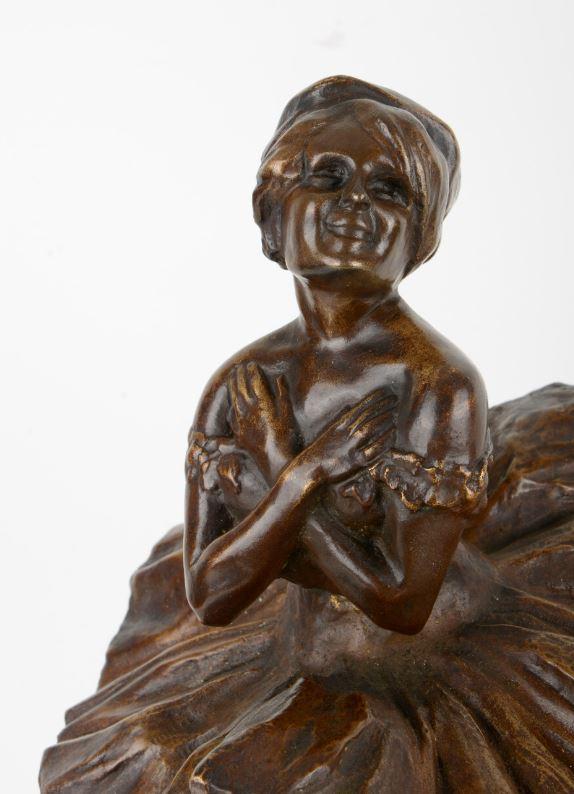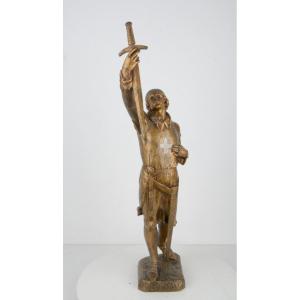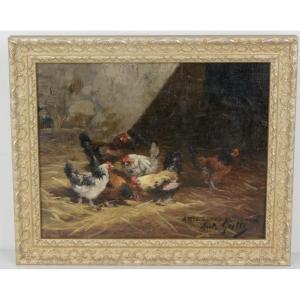Stamp of the founder: Jaboeuf et Rouard It is therefore a sand cast.
Material Bronze with brown patina.
The bronze is complete
. Charles Gir, whose real name is Charles Félix Girard, was, during the Belle Époque (in the Entre-Deux-Guerres), a key figure in Parisian artistic life. Violinist in his spare time, passionate about operas, Charles Gir paints and sculpts, but to round off his ends of mine, he creates advertising posters for the theater, illustrates literary works and composes press cartoons and caricatures for various satirical magazines. such as the Butter Plate.
Charles Gir was born on November 1, 1883 in Tours. Salesman in a Tours bookstore, young Charles expects more from life. He escapes by bike to Paris. He trained at the Boulle school and at the drawing and modeling school for Garçons Germain Pilon, but it was thanks to his caricatures and press cartoons that his career took off quickly. At the same time as this journalistic career, and yielding to his love for opera, he roamed the corridors of the Palais Garnier, attending classes, ballet rehearsals and the ballets themselves.
The First World War will set his life on new paths. But in the meantime, her many ballerina pastels, and in particular the Pavlova or the Karsavina, have earned her great fame.
The events of the summer of 1914 lead Charles Gir, like thousands of his fellow citizens, into the muddy trenches of north-eastern France. Gassed, he was evacuated and his recovery was laborious. He was then assigned to the “camouflage” section where he found many musicians, writers, painters and sculptors. He does not abandon his pencil and sketches the universe of Hairy people with a greedy stroke. For a wide variety of reasons, the Opera, its mysteries and its beauties has always made people dream. From the Consulate until the First World War, it is the essential place of the cultural and social life of good Parisian society. Until 1875, three halls hosted shows. Then a new Opera, wanted by Napoleon III, and built by the architect Charles Garnier, was inaugurated with great pomp on January 5, 1875. It therefore became the temple of French dance. However, with the 20th century, the direction of the Opera, more attracted by the beauty and the exoticism of foreign ballerinas, abandoned the French dancers whose technical and artistic qualities were often much superior to those of foreign ballerinas ...
Charles Gir, fascinated by dance and the Opera, haunts its corridors. He draws, as Edgar Degas (1825-1898) had done shortly before him, ballerinas on stage, in rehearsal, at rest. Perched on a high stool, although at rest, the ballerina still seems to be in the movement of her dance. A graceful smile on her lips, her eyes still focused, her hands crossed on her chest, she still seems lost in the music. Vaporous, her tutu puffs around her like a harmonious corolla. Very few artists have represented this theme of the opera ballerina. Charles Gir, passionate about this universe, excelled there and his works on this theme evoke monuments of sweetness and beauty.
A renowned foundry: the Jaboeuf et Rouard Foundry Created in 1828 by the Boyer brothers, the foundry initially offered fireplace fittings, but also sculptures. On December 27, 1887, two merchants, Albert Jaboeuf and Georges Bezout bought the lease and continued the previous activity of melting works of art, statues and public monuments. In January 1899, Georges Bezout sold his shares to Albert Jaboeuf who then joined forces, in July 1899, with Henri Rouard. The 1900 catalog, the same year the foundry was awarded a gold medal at the Universal Exhibition, offers some 1,200 models. The foundry only produces sand castings. In 1901, the foundry notably produced the monumental statue of Auguste Bartholdi, Vercingétorix, intended for the city of Clermont-Ferrand. Other rewards followed, and Henri Rouard chaired the Union of Founders from 1906 to 1923. Suffering from a serious illness which rendered him incapacitated in 1917, Albert Jaboeuf died in 1919, aged 58. However, the foundry continued to operate under the corporate name of Jaboeuf et Rouard until 1924. The last catalog of the foundry was published in 1935.
To go further: https://www.lestresorsdegamaliel.com/sculptures/288- le-repos-de-la-ballerina.html
COPYRIGHT
















































 Le Magazine de PROANTIC
Le Magazine de PROANTIC TRÉSORS Magazine
TRÉSORS Magazine Rivista Artiquariato
Rivista Artiquariato